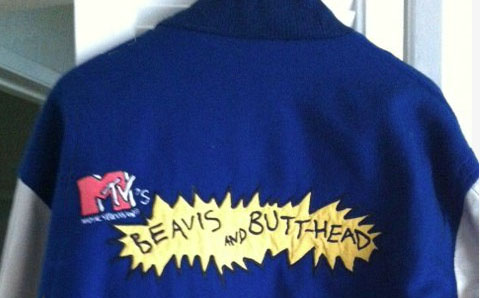

“How Beavis Saved My Life” by John Andrews
When it started airing on MTV in 1993, Beavis and Butt-Head was more than just a popular animated series, it was a cultural phenomenon. Its subversive humor centered around two terminally moronic teenagers became a hit with MTV’s viewership, not to mention a lightning rod for controversy and a focal point for discussion on the state of American culture: was the show promoting ignorance or a sly commentary on the inanity of contemporary society? The debate continued throughout the 1990s as Mike Judge’s dimwitted creations rocketed to stardom.
Tonight a new episode of Beavis & Butt-Head will air on MTV for the first time in 14 years. It remains to be seen whether the new incarnation can connect with a snarkier Internet-bred generation, but to mark the occasion, we thought it would be fitting to take a look back at the show’s roots. Cartoon Brew invited the show’s original producer, John Andrews, to write a personal essay recalling his experiences as a key member of the original crew and tell us about the behind-the-scene challenges of producing the show in the early nineties.
Andrews was hired in 1992 to produce MTV’s new series Beavis & Butt-Head and stayed for several years. He co-produced the 1996 feature Beavis & Butt-Head Do America with Abby Terkuhle. After a subsequent 13-year run at Klasky Csupo, he is now at Six Point Harness running 6 Point Media.
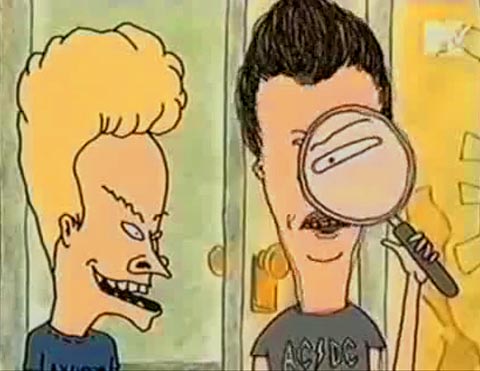
HOW BEAVIS SAVED MY LIFE
by John Andrews
I’m a fan of Mike Judge. In all my years working with animation creators, I have met very few others who have known their own creations with the thoroughness and vision Mike had from the very beginning. This is the true story of how Beavis & Butt-Head found me and changed my life.
As a budding animation producer with a few slightly tamer animation projects to my credit, mostly for PBS, I had the opportunity to jump into the job of producing the animated shorts and music video commentaries that MTV had ordered as the first season of Beavis & Butt-Head. For me this led to a five year run producing the series, co-producing the feature and launching a number of other MTV animated projects. But it all started with a leap onto a train that had already left the station, a series that already had an air-date, first scripts on the table and a whole lot of animation ahead with only a few months to make sense of it all and get something on air.
I moved to New York from Providence, Rhode Island, in 1981 with my rock band The Mundanes. The early eighties recession got the best of us and we all moved on. I settled in to a life of producing graphics and animation for TV and trade shows. I even won a few Emmys for the goofy Monty Python-esque animations that partner Todd Ruff and I put together for a business series called Adam Smith’s Money World in the mid to late eighties. But by 1990, life was getting dull.
Then I got the opportunity to produce the animation for a series called The Creative Spirit for PBS, underwritten by IBM. That series gave me the opportunity to sit at Chuck Jones’ feet for a day long interview/shoot and to meet many terrific animators including Alison Snowden and David Fine, Maciek Albrecht, the folks at Buzzco, Joey Ahlbum and several other denizens of the New York scene.
One relationship I gained out of working on that series was with John Canemaker. He created wonderful animations for the series and became a real friend in that period. One night I went to a party with John, a party thrown in honor of some animators from the film board of Canada. As we stood amidst the crowd, I said to John “Who should I meet in this room?” Without hesitation he answered “Linda Simensky”. Linda was then a part of the development team at Nickelodeon. Linda and I hit it off immediately, finding that we shared a taste for off-beat bands and went to a couple of shows together over the next few months.
With The Creative Spirit under my belt, I was ready for new work opportunities, but following the rule to never appear needy in the job market, when talking to Linda I always stressed how much I enjoyed my job but how open I was to anything else that might come along. Well one day she called to say MTV had signed Mike Judge to create a series called Beavis & Butt-Head based on some shorts Mike had done for Spike & Mike’s Sick and Twisted Festival. MTV’s VP of on-air promotion Abby Terkuhle had called her looking for producing candidates. It sounded good to me. So Linda helped arrange an interview.
The story continues after the jump.
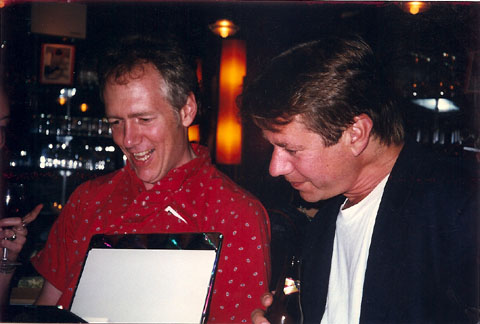
John Andrews (left) with Abby Terkuhle
Abby showed me “Frog Baseball” and “Monster Truck” and a demo of Beavis & Butt-head talking over a Metallica video. Since I was a fan of animation that wasn’t for kids, particularly Derek Lamb’s work and the work of Will Vinton, Ralph Bakshi and the above mentioned Alison and David — specifically animation with realistic adult characters— I was immediately intrigued by Mike’s work. I also recognized that it had a strange power. Abby mentioned that when they showed the demo to a test audience, the mid-teen boys almost jumped out of their skin, asking where they could buy it.
I guess the first interview went okay, since I was invited back for another round. In the meantime I consulted with Linda. Did she think writing up a proposed production schedule to meet their deadline for launch would be a good idea? Linda said definitely. The folks at MTV Networks love anything on paper. Sure enough when I got to the follow-up interview Abby and Christina Norman both had copies of my schedule, which I had sent over earlier, in their three-ring production binders. I had a sense that I was in.
So essentially I got hired before I met Mike and he was handed over to me when he got to town. Mike was meeting a lot of new people, being asked to do lot of new things and doing his best to make sense of it all in a very foreign place, New York City. He had no place to live and very quickly tired of the tiny rooms and hallways full of people dressed in black at the Paramount Hotel where MTV put up all visitors at the time. So on weekends he was exploring the suburbs that many of MTV’s writing staff inhabited.
Mike ended up following me home one night, stayed for a few more and, after a couple of days of looking around Westchester, settled on a $1,600 a month condo in Portchester, NY. It wasn’t much, but it felt right to a young married Texan with a small daughter and anything more expensive seemed excessively risky. I tried to encourage Mike to risk a bit more capital by telling him I was convinced he would soon be a millionaire, which I truly believed and which he eventually, although not soon enough, became. Within the first year he had upgraded to a nicer condo and then a house in Rye where I was living. We had some good times up there. Mike came over and jammed with my band, taught me tricks on the string bass and tunings on the Electric Hawaiian guitar and the family swam in my pool.
Meanwhile Beavis needed to be on air in 5 months and the network wanted it to run daily. What? How was this to happen? The network’s first step was to assign several scripts each to all the writers in the on-air promo department. There was some great talent at the network including the illustrious David Felton, the late-great Chris Kreski, who co-wrote William Shatner’s Star Trek Memories as well as many hilarious MTV on-air campaigns and that great curmudgeon Glenn Eichler who went on to channel Daria as show-runner and co-creative supervisor of that series and later re-emerged as a staff writer on The Colbert Report.
However it quickly became evident that we couldn’t expect the MTV on-air team to grind out B&B scripts forever on top of their normal duties and so we began the task of putting together a writing team of our own. At the time we were offering $500 for a 4-minute script. Eventually we came up with a scale where you could work your way up to $600, $800 and I believe maybe as much as $1,000 per script after you had cranked out a bunch. The budget was tight and the chief direction to the writers, other than stay true to the characters in Mike’s shorts and his own scripts, was to be careful not to create too many “elements”, code work for the characters, backgrounds, props and even body parts which the animators would have to create and eventually store in a digital system for reuse.
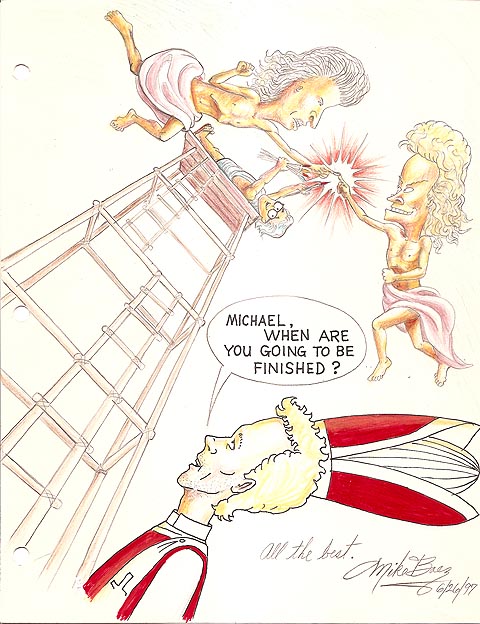
A gag drawing of John Andrews (as pope) drawn by Mike Baez
This was several years before Flash came along and it chiefly involved trying to simplify traditional animation several steps beyond what Hanna Barbera did and then composite the pieces in John Whitney’s US Animation System. The folks at J. J. Sedelmaier’s studio in White Plains were the chosen guinea pigs and a team of New York’s best, groomed in a system where anyone worth their weight pretty much knew how to do everything, did their best to understand what the hell Whitney’s minions, including the very encouraging David Lipman (later producer of many Dreamworks projects and Framestore’s Tales of Despereaux), were talking about. There were some great folks on that early team including directors Tony Kluck, Illya Skorupsky, New York animation legend Tony Eastman, designer Mike Baez, animators Bryan Moore and Ben Price, and the eventual Queen of Beavis-dom Yvette Kaplan who went on to become one of our supervising directors at MTV (along with Carol Millican) and the co-director of Beavis & Butt-head Do America. Tony K, and Illya, along with other series veterans Geoffrey Johnson, Ted Stearn, John Rice, Mike Rose, Barry Vodos and Rhonda Cox are back with the series 19 years later! And of course there were a lot of other great people involved who gave their all.
Back to the writers. Where to find them? It went like this. My first call was Rob Burnett over at Letterman. I basically asked if there were any great writers he had wanted to hire but couldn’t because he was all-full-up. He recommended Sam Johnson and Chris Marcil, graduates of HBO Downtown and a great comedy writing duo. They went on to write many B&B episodes and the pilot of Daria before moving on to Frasier and News Radio, How I Met Your Mother and Hot in Cleveland.
Next I called my friend Sandy Shapiro who was a producer at AMC to ask if she had any suggestions. She came up with Joe Stillman who had been writing on Pete and Pete. He went on to co-write Beavis & Butt-head Do America with Mike and has credits on two Shrek features. The MTV staff writers brought in their friends Larry Doyle (who later wrote I Love You Beth Cooper and joined The Simpsons staff), Billy Aronson (who pitched Jonathan Larsen the idea for Rent) and Guy Maxtone Graham (brother of Ian, a long-time Simpsons writer — yes, it runs in families).
In addition to the cartoon scripts, we needed to work in the music video element of the show. Initially when we wanted to pick videos, we were just handed a master list of ones accepted for air on MTV and told to pick whatever we wanted. Since we needed to cut these down to fit our format, on-air staffer Nick Litwinko and I were aimed in the direction of some three-quarter inch editing equipment in a room on the first floor of 1515 Broadway and instructed to have at it. There we did our first experiments with cutting down videos and intercutting shots of Beavis and Butt-Head from Mike’s own original cartoons commenting on them. I remember spending much of the Christmas holiday, when the heat was turned off in those edit rooms, trying to work it out. Eventually MTV producer Susie Lewis got a handle on this and supervised that area for the run of the series.
Then we had to come up with a format for the show. The animation segments were called VJ’s since they played the same roll as the Video Jocks on the channel as links between videos. Since Beavis & Butt-Head appear commenting on the videos in-between segments of their adventures, there was a lot of concern that audiences would not be able to follow the time-line and would be confused as to why they were back on the couch. But we knew the crew believed that the MTV audience would figure it out and they did.
Somehow by the time of our slated launch in March we had a few cartoons and videos ready but not nearly enough to be a nightly show and so we were given a reprieve, a two month period to get more show through post production and a budget increase to get more crew on for the task of picking and cutting down videos, writing comments for Mike to use as the basis for his Beavis & Butt-Head video voiceovers, getting a seat at the table at the meetings where MTV chose their videos and beginning plans to bring the animation production in-house to MTV. Meanwhile audio producer John Lynn slogged away getting the first season ready for a re-launch in May.
After the first season, Abby Terkuhle suggested we try setting up our own animation studio at MTV. I ran down to Jumbo with our first animation studio hire Diane Sparagano for a quick lesson on how to set up scene folders and a primitive database. We started interviewing overseas studios and soon we were doing our east coast impression of what Hanna Barbera, Film Roman and Klasky Csupo had been doing for years — putting together a strong front-end package and shipping it overseas! Diane introduced me to Machi Tantillo, a veteran of Pee Wee’s Playhouse and she became our production manager. Abby brought in directors Mike de Seve and Brian Mulroney from Baboon Animation. And this is where the list of great people who started flowing into our offices gets too long to even include. To be continued in the comments section! At any rate soon we had a great crew in-house at MTV!
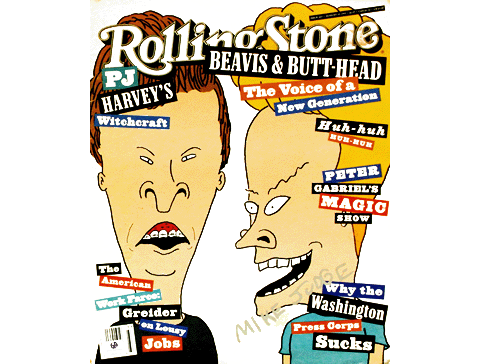
Somewhere around this time Jack Spillum over at Jumbo Pictures called to say he had a friend from LA named Kris Brown, at that time a production person on MGM’s Pink Panther series, who had written an episode of Beavis that Jack thought was good and he asked if we would take a look. Mike and I read it and it was instantly obvious to both of us that this guy really got the characters and the format. Mike arranged to meet Kris at an airport and they hit it off instantly. I suggested we offer Kris our version of a show-runner position and move him to New York. Soon Kris was overseeing scripts and records and living on the Upper West Side in a sublet we found him in the New York Times. He has gone on to write on several Judd Apatow projects including 40 Year Old Virgin and most recently has been making funny on MTV’s Death Valley and Spike’s Blue Mountain State. But before all that he held down the fort on Beavis through close to 200 cartoons.
Our schedule was intense and the days were long, starting with a 45-minute train ride in from Westchester and ending, after that last express train, with two beers on that 55-minute local. Mike and I often rode into and/or out of the city together and, as his producer, I often felt compelled to force him through scripts and storyboards in preparation for the next big meeting. The pressure was unrelenting to create this content and it only got worse after the show hit and was a success. The politics got complicated as the stakes got higher and higher, but somehow we all held it together through 5 of the most intense years imaginable.

Beavis and Butt-Head production crew jacket
A fantastic crew of New York animation professionals – great directors, storyboard artists, designers, colorists – was gradually assembled at MTV. They too have gone on to notable careers throughout the industry, on both coasts and around the world. At one point MTV Animation was 130 people strong. It was a fantastic scene to be inside in those years and we all miss it. Everyone who was a part of it has an interesting story to tell of how it came into his or her life.
There are a million stories around the birth of this giant. Here are a few of mine but everyone involved has a long list of their own.
* After Mike recorded the first scripts, we rode around laughing at cassettes copies of them on our car radios for months before we ever saw animation.
* The first Beavis walk cycle was animated by a French animator who made them pigeon-toed and like something out of The Triplets of Belleville. Thankfully that inspired Mike to redo it himself and establish for all time the Beavis & Butt-Head walk.
* With only a tiny talent budget available, we stumbled our way into establishing a voice cast, hiring amateurs from comedy clubs and the receptionist at the sound house. I played the first few female characters. Mike was still doing the lion share of the voice work all the way through the series’ run.
* I had the experience of going home one night and seeing on TV two little girls in Newark, New Jersey sitting in front of a burned living room curtain as they explained to the news camera how they had tried to light an aerosol canister. They argued over which one was Beavis and which was Butt-Head as they described the process of lighting the can.
I honestly feel guilty not including a list here of every one of the beautiful New York animation professionals (and a few LA transplants) who made Beavis & Butt-Head happen in those early years. Because of this, I am not going to mention a single name more. But many loom large. They know who you are and they are all beloved. We still share a bond and gather in various combinations on both coasts.
Now, as the new episodes come to TV, featuring some of the best of the talent in writing, animation direction and storyboarding from the original series, those of us who were there at the beginning can watch from the sideline and cheer on our heroes. I think it actually saved the lives of many of us, those in earlier and later stages of our professional careers. So many thanks to very talented Mike Judge for turning up when he did and re-charging all of us. Beavis saved my life.
